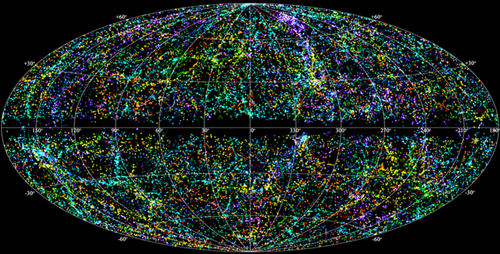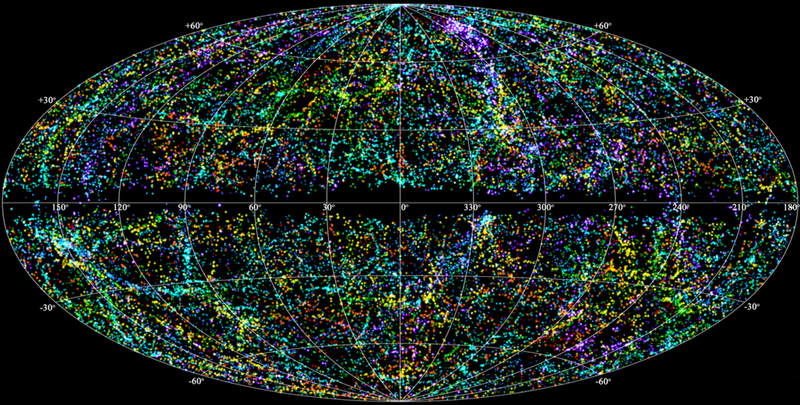Radio Signals May Reveal Cosmological Structure
A basic goal of observational cosmology is mapping the three-dimensional distribution of matter in the Universe. Such efforts require accurate estimates of distances to faint, faraway galaxies, a task that has always been difficult. Two cosmologists now propose an entirely new way to gauge large-scale cosmological structure. The technique involves analyzing brief bursts of radio waves from a recently discovered class of astronomical objects—the further these signals travel, the greater the distortions that appear in them. The feasibility of the method depends, however, on as-yet unknown properties of the emission sources.
Comparison of the observed large-scale structure of the Universe to theoretical predictions is an important test of cosmological theories, but astronomers have few ways to estimate cosmological distances. They can measure the brightness of an object with a known intrinsic luminosity or measure the redshift of the object's spectrum, but both of these methods suffer from uncertainties or systematic biases. A new method to estimate large-scale structure potentially offers an independent perspective on an issue of fundamental significance.
In 2007, astronomers detected a burst of broadband radio emission lasting only a few milliseconds [1]. They found that the burst's longer wavelengths arrived later than the shorter wavelengths, the time lag being proportional to the square of the wavelength. This delay is characteristic of “dispersion” in the speed of electromagnetic radiation traveling through a charged plasma, such as the exceedingly sparse free electrons that fill intergalactic space. According to this explanation, the source of the burst was extremely bright and at a distance of almost 1000 megaparsecs (Mpc), or 3 billion light years, the astronomers found.
Ten such fast radio bursts (FRBs) have now been reported, says Kiyoshi Masui of the University of British Columbia (UBC) in Vancouver, Canada. He and UBC colleague Kris Sigurdson have now considered whether observations of a large number of FRBs could yield estimates of their distances, which could then serve to probe the three-dimensional distribution of matter in the Universe.
The dispersion in a signal arriving from an FRB depends on the number of electrons along the line of sight. Masui and Sigurdson define what they call a “dispersion distance” for an FRB—the distance obtained by assuming that the electron density is the same everywhere at a given time but decreases uniformly as the Universe expands.
In reality, electron density varies in space. Masui and Sigurdson describe several ways in which electron density variations lead to errors in distance estimates and therefore in cosmological parameters. For example, a region of higher electron density between us and a galaxy cluster containing FRBs will make them appear farther away. This would lead to an overestimate of the true distance between the FRBs and an underestimate of the extent to which they and surrounding matter are found in clumps or clusters.
To gauge the magnitude of such distortions, the researchers analyze a simple model in which electron density follows the density of galaxies, which in turn reflects variations in the density of the dark matter that constitutes the bulk of the mass in the Universe. With these assumptions, Masui and Sigurdson show that dispersion measurements of about 10,000 FRBs could yield an informative estimate of cosmic density variations, despite the various sources of inaccuracy, and even in the absence of direct redshift or other distance measurements.
The researchers also point out some significant caveats. Dispersion is produced not only by intergalactic electron density but also by the immediate environment of an FRB, whatever that might be, and by our own Galaxy. The galactic contribution can, in principle, be measured and subtracted out, the researchers say, but dealing with the unknown dispersion close to the FRBs will be more difficult. A large survey might reveal similarities in FRB emissions, which could simplify the analysis. But if individual FRBs turn out to vary wildly, Masui says, interpretation of dispersion distance will be far more difficult.
“Finding distances to objects is one of the hardest things to do, so any new ideas are warmly welcomed,” says Martin White of the University of California at Berkeley. The proposed new method appears very promising, provided enough FRBs are found, he adds, but whether it is observationally feasible, “we’ll have to wait and see.”
This research is published in Physical Review Letters
–David Lindley
David Lindley is a freelance science writer in Alexandria, Virginia.
References
- D. R. Lorimer, M. Bailes, M. A. McLaughlin, D. J. Narkevic, and F. Crawford, “A Bright Millisecond Radio Burst of Extragalactic Origin,” Science 318, 777 (2007).





